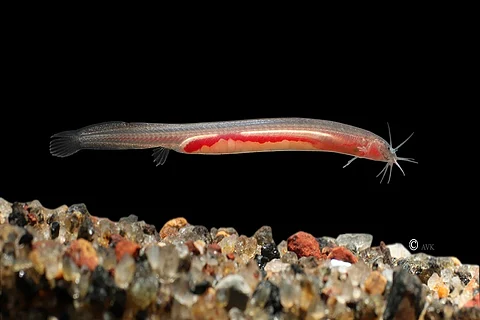

When Kozhikode-based graphic designer Vishnu Das opened a tap to fill up a bucket in his bathroom five months ago, he was not expecting to discover a brand new eel.
A tiny, translucent fish plopped into the water and swam about. Initially, Vishnu assumed the thing to be a juvenile mottled eel, also known as ‘mananjil’ in Malayalam. But being a fish enthusiast, he decided to take pictures of the specimen and fact-check.
Soon enough, the picture reached researchers at the Kerala University of Fisheries and Ocean Studies (KUFOS), who realised that Vishnu’s accidental discovery in his bathroom in Cherinjal was, in fact, a new species of eel-loach — the first in the world to be found in a subterranean environment.
“Usually eel-loaches are found in fast-flowing streams of south and south-east Asia. Some species are found in Indonesia and the North-Eastern parts of India. This is the first subterranean eel-loach species to be found in the world,” says Rajeev Ragavan, assistant professor at the Department of Fisheries Resource Management at KUFOS, who is leading the team studying the species.
The new eel-loach was christened Pangio Bhujia, after the popular north-Indian snack bhujia sev, made up of tiny edible sticks. According to Anoop, the species was named after the snack due to its size. The biggest specimens of this species grow to a maximum of 3.5 cms in length and 3 mm in width.
Reasons for discovery
Researchers found that the eel-loach in Vishnu’s bathroom came from a house well used for drinking and irrigation purposes. But how this aquatic specimen ended up in this well is a mystery in the process of being solved.
“We searched the well and couldn’t find any other specimens of Pangio Bhujia. This was perplexing. However, after a little bit of inspection, we found at least 15 specimens of the Pangio Bhujia in a pond 200 metres from this well. The pond was connected by a channel which led to a paddy field,” adds V K Anoop, another researcher who is part of the team.
A team comprising of researchers from KUFOS, Indian Institutes of Science Education and Research (IISER) Pune, Malabar Awareness and Rescue Centre for Wildlife (MARC) Kannur and Natural History Museum, London, is currently studying the species.
Based on research conducted by this team, it was found that the eel-loach species is found in underground water channels commonly found in laterite soil zones.
Either due to the 2018 floods or water scarcity in 2019 that Kerala experienced, the species could have surfaced from these underground channels to wells and ponds.
“The underground water channels are connected. Sometimes when you draw water from a well, another water body several metres away will get drained. This can possibly explain how one specimen of the fish was found in the house well and the rest about 200 metres away in a pond,” says Rajeev.
Rajeev also added that post the floods, several discoveries of subterranean species have been made in Kerala, probably indicating a geological change that came about as a result of the floods.
New species has distinct physical features
The Pangio Bhujia is a slim, translucent specimen from the Pangio genus, which is vastly different from the other species that have been discovered earlier. The main difference in the Bhujia is the absence of the dorsal fin and the pelvic fin.
“They even have very tiny eyes and full-length nasal barbels which are different from the other species,” says Anoop.
Pangio Goanesis aka the Indian Coolie-loach discovered in Goa, and the Pangio Ammophila are among the other species of the Pangio genus found in India.
While the Bhujia retains the physical traits of the Pangio genus — the shape of its mouth, its head and the bone near its eyes — they are vastly different from other eel-loaches. Although the reasons for these striking differences are yet to be established, there is speculation that the other species of the Pangio genus evolved from the Bhujia, as the species shows more primitive features as compared to the others, Rajeev says.
“The Pangio Bhujia is extremely transparent. In fact you can see the caudal fin and the bones inside the eel-loach if you look. We are studying the bones and conducting other genetic analysis to understand the origin of this species,” Anoop says.
This is not the first subterranean fish to be discovered from Kerala in 2019. In May this year, a subterranean snakehead fish which was named 'Aenigmachanna gollum' was discovered in Malappuram.
A study team which included members from KUFOS said that the Gollum could have landed up in Kerala as a result of the 2018 floods. It was also named Gollum, as the fish species could have modified its physical features to adapt to life underground, much like the literary character from JRR Tolkien’s Lord of the Rings.
Also read: